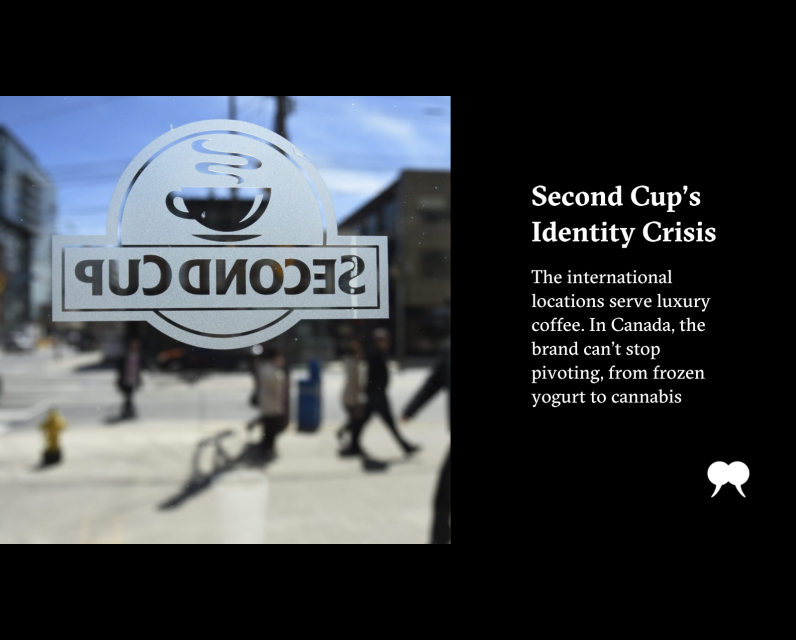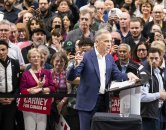Second Cup’s Identity Crisis

It was a scorching August morning, and we had to beat the heat. A trip to the coast was ideal. To fuel up for the three-hour drive, my family and I picked up our caffeine fix: an iced green tea latte for me, an iced salted caramel latte for my cousin, and two boring but delicious flat whites for his parents—all from Second Cup. Located near my uncle’s house, the branch was usually my first stop on a road trip. It was also one of my go-to study spots as a university student. The upscale interior with its beautiful furniture, warm lighting, and patient staff was also ideal for people-watching. And while Second Cup is ubiquitous in Canada, it might be surprising for many to learn that this favourite branch of mine is located in the historic neighbourhood of Korba, in Cairo. It’s one of more than thirty locations in Egypt.
After years of frequenting the Korba Second Cup on trips back to Egypt, I decided to visit the coffee shop in my second home, Vancouver. I figured a chain that has garnered such popularity internationally must be a heavy hitter in its country of origin. But I couldn’t have been more wrong. At the time, the only location in Vancouver was at the BC Children’s Hospital (it has since shut down). And if grabbing a coffee in a lobby designed for sick children wasn’t enough of a deterrent for me, images of the cafe on Google Maps imparted to it an uninviting ambience: sterile decor, a wall of beige pastries, and somehow the noisome vapours of plastic gloves and rubbing alcohol. Is this all “Canada’s largest speciality coffee retailer” has to offer in a major city?
As it turns out, this standard was customary for many a Second Cup in Canada. Browsing through pictures of different locations, from Surrey to Calgary to Ottawa, I found that most are dated, unattractive, or simply ordinary. No branch looked like the next, and none of them seemed to suggest the inviting experience I had at Second Cup in Egypt.
This August, the company celebrated its fiftieth anniversary. But it is in a strange spot: it doesn’t speak the Tim Hortons-ian language of the working class, nor does it employ Starbucks’ exceptionally well-trained baristas—despite pricing similarly. It has also evolved in various ways that haven’t coalesced into a cohesive brand identity. In 2017, led by then chief executive officer Garry Macdonald, Second Cup signed a licensing agreement with Pinkberry Canada that allowed it to roll out a frozen yogurt program in Second Cup cafes across the country. The following year, the board partnered with marijuana clinic operator National Access Cannabis to convert select Second Cup locations into cannabis dispensaries and potentially open cannabis-friendly cafes once it became legal to do so. Seven stores eventually opened in Ontario, six of which were in former Second Cup locations. More recently, Second Cup has been popping up in multi-brand stores alongside Pita Pit and Chocolato.
Shortly after its acquisition by Foodtastic in 2021, one customer used TikTok to voice his confusion over the brand’s floundering identity. He’s a fan of the drinks, but he’s puzzled. “What is Second Cup doing? Why can’t they pick a lane? Every time I see them, they’re changing, they’re pivoting. They can’t seem to decide who they are,” he says. Back in the 1980s and ’90s, before Second Cup had much competition in the Canadian coffee market, it was regarded as upscale. People aspired to buy their beverages. “They start you on Italian soda and then you want the harder stuff,” says The Walrus digital editor Monika Warzecha, who grew up thinking of Second Cup as “fancy.” Nowadays, however, many of the Canadian locations don’t offer the high-end experience typically associated with specialty coffee outlets: clean, modern interiors and freshly baked offerings. So how did this Canadian business manage to grow and prosper internationally while its domestic brand became impossible to pin down?
Second Cup’s first location opened in August of 1975 as a shopping mall kiosk in Toronto selling only whole coffee beans. It was co-founded by Tom Culligan and Frank O’Dea, whose business partnership began with a venture to sell coin sorters to Catholic churches. Within the decade, Culligan purchased O’Dea’s shares and became the company’s sole owner. He then expanded Second Cup into a nearly 150-store chain before selling it to food and beverage entrepreneur Michael Bregman in 1988. Bregman went on to build the chain into a pioneer in the coffee shop industry until he, too, sold it in 2002. Since then, Second Cup Café has had numerous owners, including Cara Operations Limited and Dinecorp Hospitality.
Online, the coffee chain’s homepage boldly declares that the chain is “proudly Canadian,” but the website does little to show us how that’s the case. Their summer special menu included a “campfire delights” section that honoured the nationally beloved seasonal activity and took inspiration from the Nanaimo bar. But alongside these, they offered an iced matcha with strawberry rose cold foam and a number of tropical spritzers whose Canadianness one would struggle to make a case for. The website also doesn’t do much to distinguish the company: visuals of the food and beverages are quite basic, and some information provided about the stores is outdated. What stands out the most, though, is the complete absence of their international expansion and locations.
A quick google of “Second Cup global” reveals a whole other website, with different branding, covering the chain’s roughly 170 stores across twenty countries. In contrast to the first website, this one appears more high end. It features aesthetic images of their locations and menu items, highlighting their quality and freshness. This version of Second Cup promises a “premium sustainable cafe experience to each of our guests.” My curiosity piqued, I dug. Deep. And there, nestled in only a handful of articles about the chain like some kind of classified information, was the mystery’s key: there are two Second Cups.
In 2003, Second Cup opened its first international locations in Kuwait and the United Arab Emirates, kickstarting an expansion journey that would eventually make Second Cup a globally recognized brand. The great divide happened in 2008. After the death of company chairman Gabriel Tsampalieros, Second Cup’s trademark rights were split between Canadian and international. Jim Ragas, formerly the vice president of international business development and operations, became president in 2011 and has led the international company ever since. Meanwhile, Canadian Second Cup changed leadership multiple times—sometimes abruptly so—until its most recent sale by Aegis Brands to Foodtastic, a Quebec-based restaurant franchiser managing twenty-seven brands. The concentration of Foodtastic’s work in eastern Canada is perhaps one of the factors explaining Second Cup’s western alienation.
Nick Brown, founder of Daily Coffee News, an online news outlet by Roast Magazine covering developments in the specialty coffee industry, believes that such frequent changes of ownership and corporate leadership often bring shifting priorities that can cause a large company’s identity to “mutate over time.”
But what some regard as an identity crisis, Brown suggests is an effective strategy. “Large coffee brands constantly test concepts on customers,” he says. “It’s a pattern we see with successful chains.” Brown acknowledges that loyal customers may feel betrayed or disoriented by these changes. “The reality, however, is that the Second Cup that had started as a fiercely loyal single location kiosk in 1975 has transformed and developed different corporate and global interests.”
Upon acquisition, Foodtastic promised to add 100 new Second Cup locations over thirty-six months to the 211 operating at the time. But with frequent reports of openings and closures nationwide, the number of active locations remains in constant flux and is nearly impossible to ascertain, especially since the list of locations on the company’s website is outdated and inaccurate. It’s also unclear how much of Foodtastic’s growth can be attributed to Second Cup without access to the brand’s financials. The company did not respond to requests for an interview.
Meanwhile, the international side of Second Cup hasn’t changed leadership since the companies split. For nearly two decades, it tested out new markets for the brand—which yielded mixed results. It had a stint in the US, with locations in Boston and Florida, but all locations ultimately shut down. In the UK, Second Cup is now seeking a master franchise to rebuild its presence after all eleven sites it used to operate ceased their activities. Over in Pakistan, Second Cup celebrated its tenth anniversary and opened its fiftieth location this July. Ragas, chief executive officer of Second Cup internationally, was notably present at the celebration.
Despite Second Cup’s varying performance in global markets, their commitment to serving high-quality products in an upscale cafe environment has stayed consistent over the years. Yahya Ghamdan, chief executive officer of Maximum Stores, the master franchise managing Second Cup’s Egyptian locations, emphasizes Second Cup’s focus on customer experience. “Our store designs cater to different customers’ needs by offering multiple experiences,” he says. “We have seating areas indoors and outdoors, as well as studying and smoking areas, and all are furnished for maximum comfort.” He is also keen that their success is achieved through collaboration with and guidance from the Canadian parent company.
But all is not rosy for the international Second Cup. On May 22, the company obtained protection under the Companies’ Creditors Arrangement Act after its majority creditor, Arbat Capital Group Ltd., filed an application for protection. Arbat’s shareholders and directors were growing increasingly concerned regarding the Second Cup Company Inc.’s ability to repay its loans without restructuring. CCAA proceedings are designed to help companies stabilize their operations and explore debt-restructuring options. The Walrus’s inquiries into the company’s future plans in light of this process all went unanswered. Ghamdan maintains, however, that the situation doesn’t impact global locations’ operations. “The company involved us in the situation from day one and made it clear that they will resolve the situation without partners being affected,” he says.
Conversely, all is not lost for the Canadian Second Cup’s brand identity. Prompted by the US–Canada trade war, many Canadians boycotting American companies turned to Second Cup for their morning cup of Joe instead of Starbucks. Some of these customers are rediscovering Second Cup after years away from the chain. Second Cup now has a unique opportunity to capitalize on its Canadian origins by rebuilding its identity to highlight them in its branding, menu, and location strategy. A nostalgically Canadian-forward identity, if you will. I hope they don’t start selling burgers.
The post Second Cup’s Identity Crisis first appeared on The Walrus.



Comments
Be the first to comment